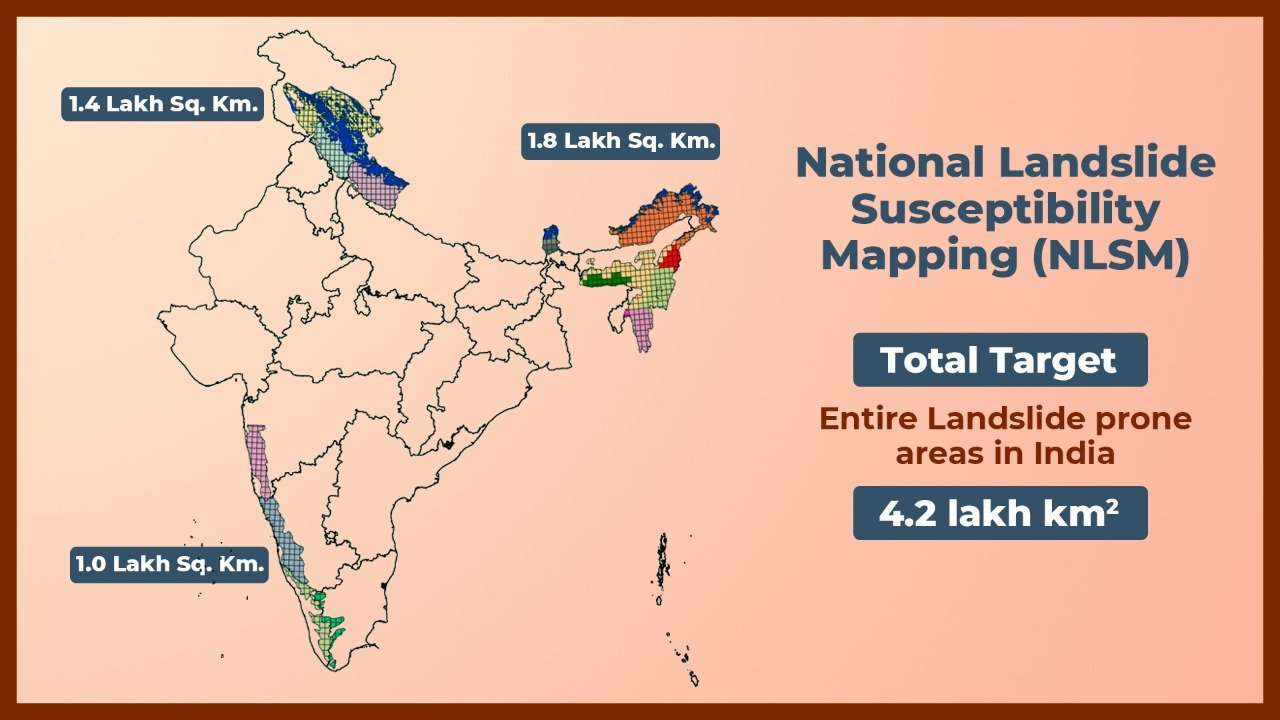-
17 Jan 2025
GS Paper 1
Geography
Day 41: In light of India’s increasing vulnerability to landslides, critically analyze the interplay between fragile ecosystems, unplanned development, and ecological degradation. Propose effective strategies to mitigate landslide risks. (250 words)
Approach
- Provide a brief overview of Landslide Vulnerability in India.
- Analyze the interplay between fragile ecosystems, unplanned development, and ecological degradation.
- Propose effective strategies to mitigate landslide risks.
- Conclude Suitably.
Introduction
A landslide is a geological phenomenon involving the downward movement of a mass of rock, soil, and debris on a slope. As per the Landslide Atlas of India, around 0.42 million sq. km (12.6% of land area) is prone to landslides. Regions such as the Western Ghats, Himalayas, and the Northeastern states are especially prone to such disasters. The growing risks are largely driven by unregulated urbanization, deforestation, and other forms of ecological degradation.
Body
The interplay between fragile ecosystems, unplanned development, and ecological degradation:
- Fragile Ecosystems: Some of the main factors that influence landslides are lithology, geological structures like faults, hill slopes, drainage, geomorphology, land use and land cover, soil texture and depth, and weathering of rocks.
- For instance, the Himalayan region, characterized by its steep slopes and heavy monsoon rainfall, is particularly susceptible to landslides.
- Unplanned Development: Unplanned and unsustainable development in fragile hill stations, towns, and rural areas has exacerbated landslide risks.
- Construction activities on steep slopes, without adequate consideration for soil stability or drainage systems, have disrupted the natural balance.
- The 2013 Uttarakhand disaster serves as an example, where reckless construction and poorly planned roads along fragile slopes contributed to the intensity of the floods and landslides.
- Ecological Degradation: The degradation of ecosystems is a critical factor that amplifies landslide risks.
- Deforestation for agriculture, logging, and urbanization removes natural vegetation that helps stabilize the soil.
- In Wayanad, the 2024 landslide incident highlighted the direct link between deforestation and soil instability.
Strategies to Mitigate Landslide Risks:
- Building Resilience: To address these challenges, it's important to develop resilience against geo-hazards caused by natural processes, environmental degradation, and human activities.
- National Landslide Risk Management Strategy (2019) is a comprehensive strategy addressing hazard mapping, monitoring, early warning systems, awareness programs, capacity building, policies, and stabilisation measures.
- Reforestation and Afforestation: Restoring degraded landscapes through reforestation and afforestation is one of the most effective ways to stabilize soil and prevent landslides.
- In Himachal Pradesh, the government has initiated large-scale afforestation projects to restore degraded forests and reduce soil erosion.
- In parts of Darjeeling, soil conservation methods like terracing and using retaining walls have helped reduce landslide incidents during the monsoon season.
- Leveraging Technology for Effective Monitoring: Web-based sensors such as rain gauges, piezometers, inclinometers, extensometers, InSAR (Interferometric Synthetic Aperture Radar), and total stations can help monitor vulnerable areas.
- The development of an integrated Early Warning System (EWS) using AI and Machine Learning (ML) algorithms is crucial in densely populated and built-up zones.
- Sustainable Socio-Economic Progress: Recognise the region's valuable natural resources, such as glaciers, springs, minerals, energy sources, and medicinal plants, for sustainable socio-economic development.
- There is a need to map towns and assess load-bearing capacities to develop robust building codes for safe construction in hazard-prone areas
- Promoting Community-Based Disaster Management: Community-based early warning systems, which involve local participation, have proven effective in areas like Uttarakhand, where local knowledge of terrain and weather patterns is combined with modern technology.
- Japan’s community-based approach also includes the construction of "disaster shelters" in landslide-prone areas, where people can seek refuge during emergencies.
Conclusion
The National Guidelines on Landslides and Snow Avalanches, issued by NDMA, outline strategies for risk assessment, mitigation, and disaster management to minimize loss of life, property, and ecosystems. Implementing these guidelines, along with stronger regulations and community initiatives, can reduce landslide risks, enhance resilience, and ensure environmental sustainability and safety in India.





